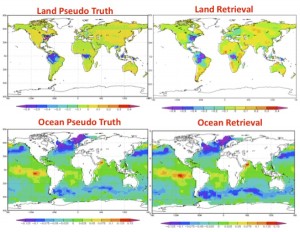NASA Carbon (Pawson)
Atmospheric Modeling, Assimilation and Source-Sink Estimation for the Carbon Cycle
NASA MAP 2008-2011
We developed an assimilation system for the global carbon cycle, which will ingest in-situ and space-based observations into models of physical processes and carbon cycling. It will be used to give estimates of the seasonal cycle of carbon fluxes, including year-to-year variations, along with measures of uncertainty in these fluxes. It will extend GMAO’s “physical” data assimilation systems to the carbon cycle. It will incorporate existing models for land and oceanic carbon processes; carbon species will be added to the GEOS-5 atmospheric assimilation and an inversion methodology will be implemented. The coupled assimilation will be developed in two stages.
In the first stage, we will examine consistency between carbon sources and sinks derived from bottom-up and top-down approaches; interpretation will be in terms of uncertain model parameters and potential data inaccuracies. The goal is to better understand the global behavior of the models and to develop an improved knowledge of the carbon cycle. This first stage of research will build on component models and assimilations that are funded through existing projects. Bottom-up source/sink estimates will be determined using biophysical and fossil-fuel models over land and ocean biogeochemistry, constrained by satellite data (especially from MODIS) and atmospheric analyses. The GEOS-5 atmospheric assimilation system will be extended to ingest in-situ carbon observations and AIRS (later also OCO) level-1b radiances. A detailed study of atmospheric transport uncertainty will be performed. A methodology for inverting the assimilated data to improve on bottom-up source/sink estimates will be developed, after testing of various candidate systems, one of which is a new approach based upon parameter estimation using ensembles of model forecasts. Parameter uncertainty in the land and ocean carbon models will then be tested for consistency with the atmospheric estimates. The system will be used to compute finely resolved space-time estimates of CO2 exchanges between the atmosphere and underlying surface, with associated uncertainties. Because of data and model uncertainties, we will produce global source/sink distributions on scales of hundreds of kilometers.
In the second stage (years four-five) a coupled atmosphere-land-ocean assimilation will be developed to simultaneously constrain surface source/sink distributions using top-down and bottom-up information. Component modules will estimate very high-resolution (quarter degree or finer) global carbon fluxes. An ensemble assimilation, running on the land-atmosphere and ocean-atmosphere interfaces, will account for parameter uncertainty in the underlying models and observations. The goal is to produce reliable flux estimates on spatial scales of around 200km and temporal resolution of two weeks, describing the seasonal cycle of carbon in the environment.
The research system proposed here will be tested extensively on selected observational periods (such as NACP intensives). Sensitivity to input data inputs (e.g., AIRS and OCO radiances; NACP in-situ data) will be studied. It will later be run for an extended period, beginning with the EOS-Aqua launch.



